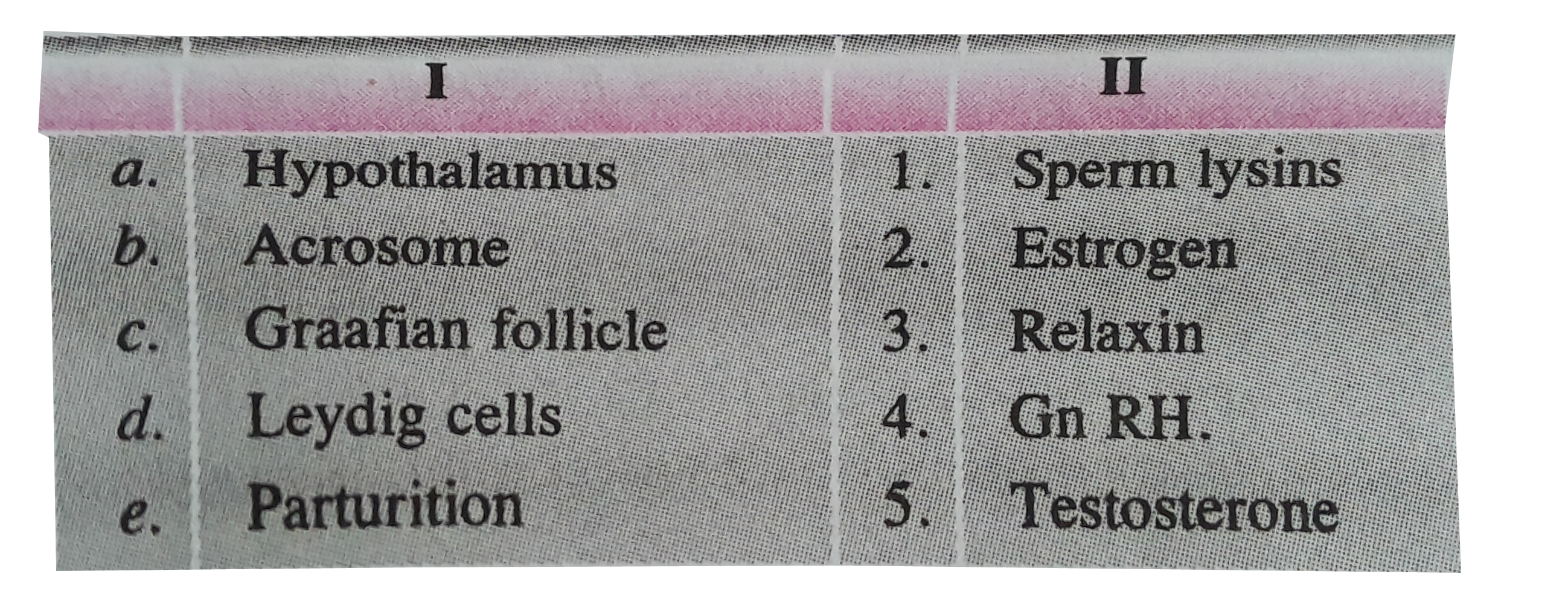Match list-I with II and select the correct option:-
(a) Adrenalin (1) Myxoedema
(b) Hyperparathyroidism (2) heart beat
(c) Oxytocin (3) Salt-water balance
(d) Hypothyroidism (4) Child birth
(e) Aldosterone (5) Demineralization
a-1 b-5 c-4 d-2 e-3
a-2 b-5 c-4 d-1 e-3
a-2 b-3 c-4 d-1 e-5
a-4 b-3 c-2 d-1 e-5
The correct Answer is:B
To solve the matching question, we will analyze each hormone in List-I and match it with the appropriate condition or function in List-II.
1. Identify Adrenalin (A):
- Adrenalin is known as the stress hormone. Its primary function is to increase the heart rate and prepare the body for a 'fight or flight' response.
- Match: Adrenalin (A) matches with heart beat (2).
2. Identify Hyperparathyroidism (B):
- Hyperparathyroidism refers to an excess of parathyroid hormone, which leads to increased calcium levels in the blood. This condition promotes bone demineralization.
- Match: Hyperparathyroidism (B) matches with demineralization (5).
3. Identify Oxytocin (C):
- Oxytocin is a hormone that plays a crucial role in childbirth by causing uterine contractions. It is also involved in lactation.
- Match: Oxytocin (C) matches with childbirth (4).
4. Identify Hypothyroidism (D):
- Hypothyroidism is characterized by low levels of thyroid hormones, which can lead to a condition known as myxoedema.
- Match: Hypothyroidism (D) matches with myxoedema (1).
5. Identify Aldosterone (E):
- Aldosterone is a hormone that helps regulate salt and water balance in the body.
- Match: Aldosterone (E) matches with salt-water balance (3).
Final Matches:
- A (Adrenalin) → 2 (heart beat)
- B (Hyperparathyroidism) → 5 (demineralization)
- C (Oxytocin) → 4 (childbirth)
- D (Hypothyroidism) → 1 (myxoedema)
- E (Aldosterone) → 3 (salt-water balance)
Correct Option:
The correct option that matches all the pairs is Option B.
- Adrenalin is known as the stress hormone. Its primary function is to increase the heart rate and prepare the body for a 'fight or flight' response.
- Match: Adrenalin (A) matches with heart beat (2).
- Hyperparathyroidism refers to an excess of parathyroid hormone, which leads to increased calcium levels in the blood. This condition promotes bone demineralization.
- Match: Hyperparathyroidism (B) matches with demineralization (5).
- Oxytocin is a hormone that plays a crucial role in childbirth by causing uterine contractions. It is also involved in lactation.
- Match: Oxytocin (C) matches with childbirth (4).
- Hypothyroidism is characterized by low levels of thyroid hormones, which can lead to a condition known as myxoedema.
- Match: Hypothyroidism (D) matches with myxoedema (1).
- Aldosterone is a hormone that helps regulate salt and water balance in the body.
- Match: Aldosterone (E) matches with salt-water balance (3).
- A (Adrenalin) → 2 (heart beat)
- B (Hyperparathyroidism) → 5 (demineralization)
- C (Oxytocin) → 4 (childbirth)
- D (Hypothyroidism) → 1 (myxoedema)
- E (Aldosterone) → 3 (salt-water balance)
The correct option that matches all the pairs is Option B.
Topper's Solved these Questions
Similar Questions
Determine the correct match for the given columns.
Column IColumn II(a)Hyperparathyroidism(i) Saltwater balance(b) Oxytocin(ii) Milk let down (c) Aldosterone(iii) Demineralization(d) Luteinizing hormone((iv) Maintains corpus luteum
View SolutionMatch column I with column II and select the correct option
List 1 List 2
Citric acid Trichoderma
Cyclosporin A Clostridium
Statins Aspergillus
Butyric acid Monascus
View SolutionMatch the column I with column II and choose correct option. Column I Column II A. Earthworm 1. Gizzard B. Cockroach 2. Caecum C. Frog 3. Clitellum D. Rat 4. Cloaca
View SolutionMatch List - I with list - II and select the correct answer using the codes given below lists:
List - I (Name of vitamin)
(I) Ascorbic acid
(II) Retinol
(III) Riboflavin
(IV) Thiamine
List - II (Deficiency result)
(A) Beri-Ber-
(B) Cracked lips
(C) Scurvy
(D) Night-blindness
View SolutionMatch the following and mark the correct option:
Column-IColumn-II(a)Hyperthyroidism(i)Parthormone(b)Hypocalcemic(ii)Cretinism(c)Hypercalcemic(ii)Grave's disease(d)Hypothyroidism(iv)Calcitonin
View SolutionMatch the columns and choose the correct answer.
(a) Aldosterone (Column I) (i) Zona fasciculata (Column II) (b) DHEA (Column I) (ii) Zona glomerulosa (Column II) (c) Cortisol (Column I) (iii) Zona reticulans (Column II) (d) Adrenaline (Column I) (iv) Adrenal medulla (Column II)
View SolutionMatch column I with column II and select the correct option from given codes.
Column IColumn IIA. Marginal(i) Sunflower, marigoldB. parietal(ii) PeaC Axile(iii) Mustard,ArgemoneD. Free central(iv) Hibiscus,ArgemoneE. Basal(v) Dianthus, Primorse
View SolutionMatch List I with List II and select the correct answer using the codes given below the list :
List IList II1.Heavy water(a)Bicarbonates of Mg and Ca in water2.Temporary hard water(b)No foreign ions in water3.Soft water(c)D2O4.Permanent hard water(d)Sulphates and chlorides of Mg and Ca in water.
View SolutionMatch List I with List II and select the correct answer using the codes given below the list :
List IList II(i)Heavy water(A)Bicarbonates of Mg and Ca in water (ii)Temporary hard(B)lather with soap water(iii)Soft water(C)D2O(iv)Permanent hard(D)Sulphates and water chloride of Mg and Ca
Code :
View SolutionMatch the columns and find the correct combination

(a) a-2, b-1, c-4, d-3, e-5
(b) a-4, b-1, c-2, d-5, e-3
(c) a-2, b-1 ,c-5, d-4, e-3
(d) a-4, b-1, c-2, d-3, e-5
View Solution
